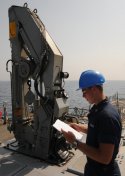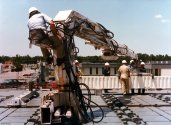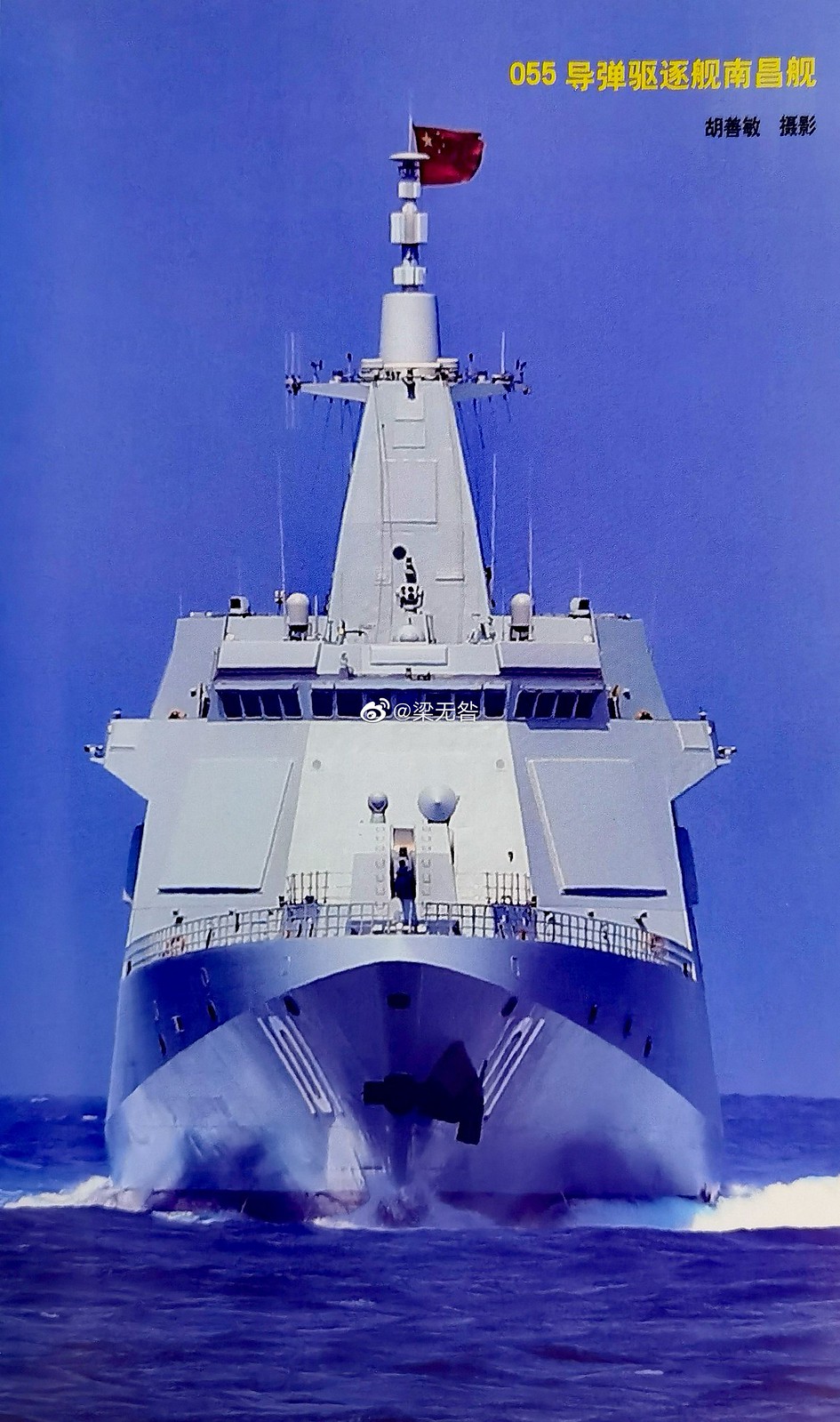You are using an out of date browser. It may not display this or other websites correctly.
You should upgrade or use an alternative browser.
You should upgrade or use an alternative browser.
055 DDG Large Destroyer Thread
- Thread starter FarkTypeSoldier
- Start date
- Status
- Not open for further replies.
I don't think there's such a thing as "too many to use". "Too many to fill" might be understandable. . .maybe. You might not be able to fill all cells on all ships at once but your could certainly shuffle munitions around so your deployed ships are topped off.I recall writings that the Ticos had too many VLS to actually be used, which is why the Arleigh Burkes only have 96 VLS cells.
But if it makes you feel better, the Type-055 VLS cells are twice the size of the Mk41 VLS on the KDX and Ticos.
That is based on 85x85cm and a depth of 9m, versus the Mk41 at 61x61cm and 7m depth
Something else to keep in mind though is the practice of having multiple missile per cell. Four ESSMs per Mk41 for instance. The larger cells of the Type 055 make this even easier. I'd MUCH rather have the 112 smaller cells of the Type 055 than the 128 of a Tico. So many more options.
All cells on Burkes/Ticos are the Strike Length. (The largest cell.) That was the standard, and what is required to fit a Tomahawk cruise missile. The smaller cells were designed so smaller ships could still use the VLS for things like SM-2 and ESSM.In order to be clear, its like this. Mk. 41 is said to be around 6.8 meters and 7.7 meters in length, but its the canister sizes that matter. Here we have 25" or .635 meters in diameter with 5.8 meters in length for one canister and 6.7 meters in length for another. Note that there is an extra meter of separation between the canister length and the physical VLS length = 5.8 meter canister length to 6.8 meter VLS length and 6.7 meter canister length to 7.7 meter VLS length. This separation should be for the exhaust transfer channel beneath the canister that routs the gas to the central plenum.
View attachment 80477View attachment 80478
U-VLS has two lengths, with a diameter of .85 meters. The first length is 7 meters and the second length is 9 meters. Now this is likely to be canister length, not physical VLS length. The shorter length is for HQ-9 launching and the second length is for YJ-18 launching. Given that the advertised length of the HQ-9 is about 6.8 meters, the canister containing it should be at least 7 meters allowable for missile space not counting cold launch compress gas battle, so the physical length of the shorter U-VLS should be around 8 meters. I estimated from the length of the YJ-18 to be around 8.2 to 8.5 meters, with the missile allowable to be a maximum of 9 meters, and the entire canister length to be around 10 meters to allow for the hot launch channel. This is because U-VLS is a CCL, and the launch system is therefore integrated into the bottom of the canister itself whereas in the Mk. 41, the bottom of the canister outputs to transfer channel.
Burke and Tico should be a mix of both 5.8 and 6.7 meter canister lengths in an undetermined amount. The shorter one is for SM-2 and ESSM and the longer one for Tomahawks and SM-6.
The 052D is likely Bank 1 and 2 = 7 meters, Bank 3 and 4 = 9 meters, rear Bank 5 to 8 = 7 meters. The two rear banks at the bow are capable of firing YJ-18s, 16 of which. The rest fires HQ-9. While the purpose of this VLS is currently air defense, a 7 meter deep VLS remains respectable and is capable of firing a future VLS launched cruise missile in the future.
The 055 might be all 9 meters because we have seen YJ-18s being fired at the rear VLS. Unless it is raised above the main deck level, which is not in this case here, the rear VLS also has to be over machinery space which constrains its depth, which explains why many smaller ships like frigates for instance, don't have rear VLS, and why the 052D's rear VLS should be HQ-9 only. The front VLS banks are ahead of the machinery space in the ship which usually starts around where under the superstructure is. This area towards the bow is the deeper part of the ship which explains why the longer U-VLS is located in front of the superstructure but behind the foremost front VLS.
But given the 055 has 9 meter VLS without a raised main deck at the rear is pretty impressive, and this suggests to me that every one of the 112 VLS on the ship is a ginormous 9 meters in length. If you put that in Russian terms, that means each VLS is capable of firing a Kalibr or an Onix, and that means the ship has an antiship killing capacity that easily exceeds Slavas and even the Kirovs.
To put it short, a ship capable of firing 112 YJ-18/Kalibr/Klub/Onix sized missiles is pretty dope.
The US tried resupply at sea. That's why you see cell counts of 122 for some Ticos. 3 cells in each 64-cell bank had a strike down crane for reloading at sea. With a Tomahawk, the heaviest reload, in anything but glass-smooth seas it was "exciting" to say the least, so they ditched the crane.It's not just the radar, but the fire-control available on each ship to guide missiles.
The Burke ended up with 3 fire-control illuminators for 96 VLS.
The Tico had 4 fire-control illuminators for 128 VLS.
The Type-052D has 2 fire control illuminators for 64 VLS.
You can see a clear relationship between 1 dedicated fire-control illuminators for 32 VLS cells.
NB. my understanding is that the Type-055 dispenses with dedicated fire-control illuminators and uses AESA panels instead.
In any case, 112 VLS cells would be consistent with a single mission requirement for [96 VLS cells for air-defence + 16 cells for strike]
You do realise that the Arleigh Burkes and Ticonderogas have to go to port to reload as well?
And that the US fleet is overwhelmingly made up of Arleigh Burkes with only 96 VLS cells.
Or that the next-gen Zumwalt only had 80 VLS cells.
So why does a Type-055 with 112 VLS cells need any more?
---
In a Taiwan scenario, a large number of air defence destroyers can expect to be defending the beachhead and resupply ships for weeks or months. We're looking at less than 24hours for these ships to sail to a major naval base, reload, and get back to the beachhead.
Realistically, air defence destroyers on other missions would only go as far as 1500km from Mainland China for 90% of the time.
That's a maximum of 4 days for a reload to/from a naval base.
---
Also note how the USA is planning for its fleet of large AEGIS ships to naturally dwindle from 80 today to 60-ish.
From the US point of view, resupply is an even bigger issue for them.
But they are still going with fewer larger ships, and more smaller ships that have fewer VLS cells.


SM-6 is not a land attack weapon. Also, for antiship missions, it's using the same hardware, that it would already have for the air-defense mission. It's already going to have GPS (which at this point is trivial anyway) because it's not limited to line-of sight. With CEC the missile can reach out to the full range of the round. Once SM-6 is outside communication range (due to distance or horizon) it would rely on INS/GPS to get it to the correct location for its active radar seeker to start looking. For example an F-35 (or satellite for that matter) might spot a target out of range of the Aegis ship and say, "go hit this target here" and the ship could still do it. F-35 talks to ship, ship tells missile where it should start looking, and away it goes. Don't know if the F-35 can talk to the missile but it can certainly talk to the ship and send updates for it to relay to the missile, before it goes over the horizon.Well, the response to more SM-3/6 missiles is for China to build more offensive antiship missiles.
---
As for Chinese equivalent missiles, China doesn't have to worry about large numbers of ballistic missiles.
The HQ-19 (THAAD? equivalent) may already be in service, but there's no need to build them in large numbers like the SM-3
---
It also doesn't make any sense for China to build a SM-6 missile. It has too many missions which means it is overengineered and expensive.
For example, the SM-6 is tasked as an antiship weapon, yet it has a small warhead.
The Chinese Navy goes with dedicated antiship missiles like the YJ-12 which have longer-range, are cheaper and have a much bigger warhead.
The SM-6 also has GPS added for land-attack missions. Yet again, it has a small warhead.
It's also really, really expensive compared to a dedicated land-attack missile which would be longer-ranged and have a much bigger warhead.
Then you're left with the standard long-range air-defence mission against aircraft and atmospheric missiles.
For that, the SM-6 and the latest HQ-9s are roughly comparable and are a similar weight.
EDIT. Note that the US Navy is unable to field a YJ-12 type missile with a large warhead, because their Mk41 VLS cells are too small.
I'm seeing a cost of $1.8M for a YJ-12 antiship missile versus $4.3M for an SM-6, which is over twice as much. But treat that figure with caution. Plus the YJ-12 warhead is somewhere between 3-8x larger than the SM-6 warhead
As for the antiship mission, US naval SAMs have been doing this since SM-1. Think of SM-6 as a sniper meant to keep heads down, or maybe clean the radars off the superstructure until the heavier stuff gets there. While LRASM, with it's 454kg warhead, should have no problem getting through with a Type 055s radars still working one need only mission-kill the ship to get it out of action, which the SM-6 should be able to do just fine. Over the years there have been several possibilities for US antiship missiles but they just never saw a big enough need to follow through. Fasthawk, RATTLRS, etc.
It's worse than that. The Zumwalt hull already exists, and was designed to form the basis of the new cruiser from the getgo. One of the guns would have been ditched and swapped out for more VLS, larger radars, etc.. On the other hand this design isn't the final configuration anyway. Most likely somebody got a powerpoint assignment and just "Americanized" the Type 055. I swear sometimes I think the USN is it's own worst enemy.
<cough>The shutter speed on the camera is so fast it still manages to catch the two horns for the radio interferometer on the HQ-10.
On the last two pictures, there is a circular or saucer like object flying in the sky near where the image of the HQ-10 missile is. Drone or UFO... Never mind I think its a cover from the HQ-10 launcher being popped out as the missile launches. A second cap is missing from the launcher which means a second missile will shortly be launched after this for a two missile salvo.
(forgive the music)
One could be forgiven for thinking China bought the HQ-10 from Raytheon.
YJ-18A or HQ-9, the camera is from a different angle.What type of missile is being launched here at 0:35:
Doesn't look like either the HQ-9 or YJ-18A as we see those earlier and the profile is distinctly different.
Thanks.
Last edited:
- Status
- Not open for further replies.





